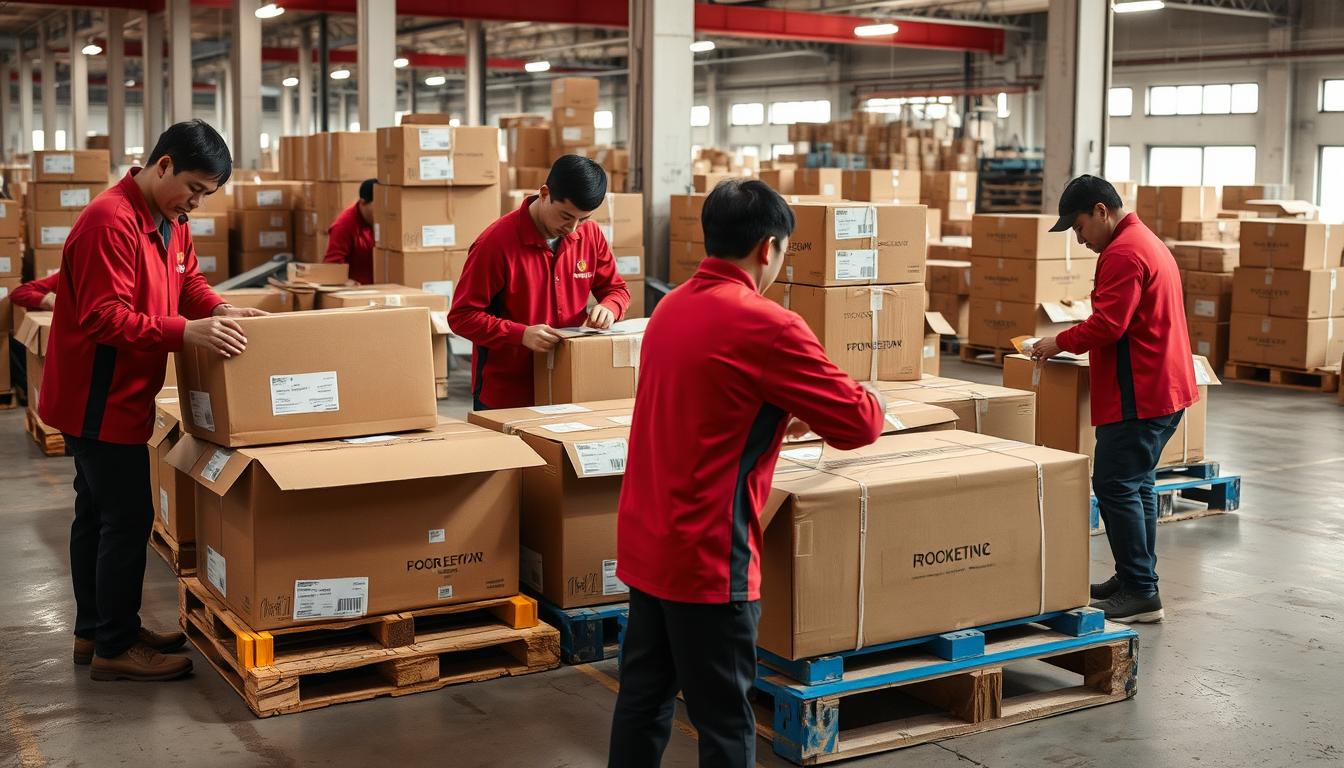Al importar desde China, entender el envío FOB (Libre a Bordo) es crucial para un comercio internacional exitoso. Con aproximadamente 70% de las exportaciones de China negociadas bajo términos FOB, es la modalidad de envío más utilizada por una buena razón. Esta guía completa te acompañará en todo lo que necesitas saber sobre el envío FOB desde China, ayudándote a navegar responsabilidades, costos y mejores prácticas para optimizar tu estrategia de importación.

¿Qué es el envío FOB desde China?
FOB (Libre a Bordo) es un término de envío internacional donde el vendedor es responsable de entregar las mercancías en un puerto designado en China y cargarlas en el buque de transporte. Una vez que la carga cruza la línea de bordo del barco, todos los costos y riesgos se transfieren al comprador, quien se hace responsable del flete marítimo, seguro y derechos de importación.

Bajo los términos FOB, el proveedor chino se encarga de todos los procedimientos y costos de despacho de exportación hasta que las mercancías estén cargadas de manera segura en el buque. Esto hace que FOB sea una opción atractiva para los importadores que desean tener control sobre el envío internacional sin lidiar con procedimientos complejos de exportación en China.
Los términos de envío FOB ofrecen una división equilibrada de responsabilidades entre comprador y vendedor, convirtiéndolo en la opción preferida para aproximadamente el 70% de las exportaciones desde China.
Cómo funciona el envío FOB desde China: Paso a paso
Responsabilidades del vendedor en el envío FOB

Responsabilidades del comprador en el envío FOB

Documentos clave requeridos para el envío FOB
| Documento | Propósito | Proporcionado por |
| Factura Comercial | Detalla la transacción de venta y sirve como base para la valoración aduanera | Vendedor |
| Lista de Empaque | Enumera el contenido del paquete, dimensiones y pesos | Vendedor |
| Conocimiento de Embarque | Recibo de la mercancía enviada y contrato de transporte | Transportista/Transitario |
| Certificado de Origen | Certifica el país donde se fabricaron las mercancías | Vendedor |
| Licencia de Exportación | Permiso para exportar mercancías reguladas específicas | Vendedor |
| Licencia de Importación | Permiso para importar mercancías reguladas específicas | Comprador |
| Certificado de Seguro | Prueba de cobertura de seguro de carga | Comprador (si se compró) |
¿Necesitas asistencia experta con el envío FOB desde China?
El equipo experimentado de REPA puede ayudarte a navegar los términos de envío FOB, encontrar transitarios confiables y optimizar tu proceso de importación desde China.
Obtén Consulta de Envío FOBVentajas del envío FOB desde China

Ventajas para los compradores
- Mayor control sobre los arreglos de envío internacional
- Libertad para elegir tu transitario preferido
- Capacidad para negociar mejores tarifas de transporte marítimo
- Transparencia en costos y horarios de envío
- Reducción del riesgo de tarifas ocultas por parte de los proveedores
- División de responsabilidades simplificada en la línea de carga
- Opción de consolidar envíos de múltiples proveedores
Ventajas para los vendedores
- Responsabilidad limitada después de cargar las mercancías
- No es necesario organizar el envío internacional
- Reducción del riesgo durante el tránsito marítimo
- Proceso de exportación simplificado con responsabilidades claras
- No es necesario gestionar los procedimientos aduaneros de destino
- Capacidad para centrarse en la calidad de producción
- Punto de entrega claro en la línea de proa del barco
Los términos de envío FOB crean un acuerdo equilibrado que beneficia a ambas partes. Los compradores obtienen control sobre la logística internacional, mientras que los vendedores pueden centrarse en sus competencias principales de fabricación y preparación de mercancías para exportar. Esta división clara de responsabilidades ayuda a minimizar disputas y agiliza el proceso de comercio internacional.
Desafíos comunes con el envío FOB desde China

Tarifas ocultas y costos inesperados
Aunque los términos FOB definen claramente la transferencia de responsabilidad en la línea de proa del barco, los importadores aún pueden enfrentarse a costes inesperados. Los cargos por manipulación en terminal (THC), las tasas de inspección de contenedores y los cargos por demoras pueden acumularse rápidamente si no se anticipan adecuadamente en su presupuesto.
Un ejemplo real: Un importador de electrónica de España enfrentó cargos adicionales de $1,200 en demoras cuando su contenedor se retrasó durante la inspección aduanera en el puerto de destino. Esto podría haberse evitado con una planificación adecuada y tiempo de reserva en el cronograma de envío.
Congestión en el puerto y retrasos
Los principales puertos españoles como Barcelona, Valencia y Algeciras frecuentemente experimentan congestión, especialmente durante temporadas altas y festividades como la Semana Santa. Estos retrasos pueden interrumpir su cadena de suministro y generar costes adicionales si no se gestionan correctamente.
Complicaciones en la aduana
Bajo los términos FOB, los compradores son responsables de la gestión aduanera de importación. La documentación incompleta, los códigos HS incorrectos o problemas de cumplimiento pueden causar retrasos, multas o incluso rechazo del envío. Trabajar con agentes de aduanas experimentados es esencial para navegar estos desafíos.
Selección del transitario
Elegir el transitario adecuado es fundamental para un envío FOB exitoso. Los transitarios inexpertos o poco confiables pueden causar retrasos, problemas de comunicación o no conseguir tarifas competitivas, lo que anula las ventajas de los términos FOB.
Cómo usar eficazmente el envío FOB desde China
Consejos de negociación para los compradores

Elegir transitarios confiables
Trabajar con el transitario adecuado es crucial para un envío FOB exitoso. Busque transitarios con:
FOB vs otros Incoterms: Comparación
| Aspecto | FOB | CIF | EXW | DDP |
| Punto de transferencia de riesgos | Cuando las mercancías cruzan la vía del buque | Cuando las mercancías cruzan la vía del buque | En las instalaciones del vendedor | En el destino del comprador |
| Despacho de exportación | Responsabilidad del vendedor | Responsabilidad del vendedor | Responsabilidad del comprador | Responsabilidad del vendedor |
| Flete marítimo | El comprador organiza y paga | Vendedor organiza y paga | El comprador organiza y paga | Vendedor organiza y paga |
| Seguros | Opción del comprador | El vendedor proporciona | Opción del comprador | Responsabilidad del vendedor |
| Despacho de importación | Responsabilidad del comprador | Responsabilidad del comprador | Responsabilidad del comprador | Responsabilidad del vendedor |
| Control de los envíos | Alto para el comprador | Bajo para el comprador | Completo para el comprador | Ninguno para el comprador |
| Lo mejor para | Importadores experimentados | Nuevos importadores | Importadores muy experimentados | Compradores que buscan simplicidad |
¿Listo para obtener una cotización de envío FOB?
REPA puede ayudarte a calcular con precisión los costos de envío FOB desde España hasta tu destino, incluyendo todas las tarifas y cargos necesarios.
Solicitar cotización de envío FOBEstudio de caso: Envío FOB desde Shenzhen a España

TechGadget, un minorista de electrónica con sede en España, importa accesorios para teléfonos inteligentes de un fabricante en Shenzhen. Anteriormente utilizaban términos CIF, pero cambiaron a FOB para tener más control sobre su cadena de suministro. Así estructuraron su proceso de envío FOB:
Situación
Implementación FOB
Resultados
“Cambiar a envío FOB nos dio el control que necesitábamos sobre nuestra cadena de suministro. Hemos reducido costos, mejorado los tiempos de entrega y obtenido una valiosa flexibilidad en nuestras operaciones logísticas.”
– Director de Operaciones, TechGadget
Preguntas frecuentes sobre el envío FOB desde China
¿Quién paga los costos de transporte en el envío FOB?
En el envío FOB, el comprador es responsable de pagar todos los cargos de transporte desde el puerto de carga (en China) hasta el destino final. Esto incluye flete marítimo, cargos de manejo en destino y transporte terrestre en el destino. El vendedor solo paga el transporte hasta el puerto y la carga en el buque.
¿Es seguro el envío FOB para pequeñas empresas?
El envío FOB puede ser seguro y rentable para pequeñas empresas, especialmente aquellas con cierta experiencia en importaciones. La clave es trabajar con transitarios confiables que puedan guiarte en el proceso. Las pequeñas empresas se benefician del control de costos y la transparencia que ofrece FOB, aunque los nuevos importadores podrían encontrar los términos CIF más sencillos para sus primeros envíos.
¿Cuál es la diferencia entre FOB punto de embarque y FOB destino?
El punto de origen FOB (también llamado FOB origen) significa que el comprador asume la responsabilidad en cuanto las mercancías salen de las instalaciones del vendedor. FOB destino significa que el vendedor mantiene la responsabilidad hasta que las mercancías lleguen al lugar especificado por el comprador. En el comercio internacional con China, los términos estándar de FOB se refieren a FOB punto de origen, con la transferencia ocurriendo en el puerto chino cuando las mercancías cruzan la línea de carga del buque.
¿Se requiere seguro para los envíos FOB desde China?
No se requiere seguro bajo los términos FOB, pero es muy recomendable. Dado que el comprador asume el riesgo durante el tránsito marítimo, adquirir un seguro de carga protege contra pérdidas o daños durante el envío. La mayoría de los importadores experimentados aseguran la cobertura de seguro para sus envíos FOB, que generalmente cuesta entre 0.3 y 0.5% del valor de la carga más los costos de envío.
¿Cómo calculo el costo total del envío FOB desde China?
Para calcular el costo total del envío FOB desde China, suma estos componentes:
- Precio FOB cotizado por el proveedor (costo del producto + transporte hasta el puerto + despacho de exportación)
- Cargos de flete marítimo
- Prima de seguro (si se compra)
- Cargos de manejo en terminal de destino
- Derechos e impuestos de importación
- Tarifas de despacho aduanero
- Transporte interior en destino
Solicite cotizaciones a agentes de carga para obtener estimaciones precisas de estos componentes.
Conclusión: Cuándo elegir el envío FOB desde China
El FOB desde China ofrece el equilibrio ideal entre control y responsabilidad para la mayoría de los importadores. Es particularmente beneficioso para empresas que:
Aunque el FOB requiere más participación que los términos CIF o DDP, los beneficios de control de costos, transparencia y flexibilidad hacen que valga la pena el esfuerzo adicional. Al entender sus responsabilidades bajo los términos FOB y aplicar las estrategias descritas en esta guía, puede optimizar su proceso de importación y construir una cadena de suministro más eficiente desde China.

¿Necesita ayuda con su envío FOB desde China?
REPA ofrece soluciones integrales de abastecimiento y logística para empresas que importan desde China. Nuestro equipo experimentado puede ayudarle a navegar los términos de envío FOB, encontrar proveedores confiables y optimizar toda su cadena de suministro.
Contacte a Nuestros Expertos en Envío

